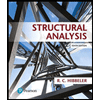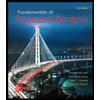
Structural Analysis
6th Edition
ISBN: 9781337630931
Author: KASSIMALI, Aslam.
Publisher: Cengage,
expand_more
expand_more
format_list_bulleted
Concept explainers
Question

Transcribed Image Text:Problem 1: Iteration Explained
Explain why iteration is required to solve the following classes of pipe flow problems using the
Darcy-Weisbach equation (<20 words each part):
Part A
Given pipe diameter D and friction head loss hj, find discharge Q.
Part B
Given discharge Q and friction head loss hy, find required pipe diameter D.
Expert Solution
This question has been solved!
Explore an expertly crafted, step-by-step solution for a thorough understanding of key concepts.
Step by stepSolved in 4 steps with 4 images

Knowledge Booster
Learn more about
Need a deep-dive on the concept behind this application? Look no further. Learn more about this topic, civil-engineering and related others by exploring similar questions and additional content below.Similar questions
- A flow distribution network is shown in Figure B. Use Darcy's Weisbach equation to calculate the head loss in the network. Compute the flow in the distribution network with the help of Hardy Cross method using the data shown in the figure below. Show the final flow distribution with the help of a neat sketch. All the flow rates are in liters/s. (300 /s (50 l/s A K=10 B K=20 K=10 K=10 E F (100 l/s (50 ) l/s (100 l/s Figure B- Water distribution network K=20 K=10 K=20arrow_forwardNEED ASAP There is a 1350 mm diameter sanitary sewer pipe with roughness coefficient of n = 0.022 and slope of 0.67%. Answer the following questions if the depth of the flow in this pipe is 659 mm: 17. How much is the capacity flow (Qc) of the proposed sanitary pipe? TIP: You may use Table No. 1 to help for calculation of the Qc. 18. How much is the velocity of the capacity flow (Vc) in the proposed sanitary pipe? 19. How much is the actual sanitary flow (Qa) of the project area? 20. How much is the velocity of the actual flow (Va) in the proposed sanitary pipe?arrow_forwardDetermine the headlosses and corrected flows in the various pipes of a distribution network shown below. The diameters and the lengths of the pipes used are given against each pipe. Make use of Hardy-cross method with Hazen-William's formula with a C-100 condition for all pipes. Perform 3 iterations. Q = 75 l/s = 300 mm 1=500 m 22 1/s A B =200 mm 1 = 300 m 101/s = 200 mm 1 = 500 m = 200 mm 1 = 300 m =150 mm 1 = 300 m 31/s E = 150 mm 1 = 500 m 15 1/s C 150 mm 1 = 300 m 31 l/sarrow_forward
- I need solution urgentlyarrow_forwardDuring the Storm sewer system (design for sewer pipes) shown in the figure 1 below using rational method. The sub-area data is provided in table 1 and table 2. At the project site, intensity is given by the equation i = 20.2 / td0.52 The intensity in in inches/hr and td = storm duration = time of concentration in minutes. Assume circular pipes are used for storm sewers. The pipe roughness (Manning's n) is given by n = 0.012arrow_forwardnotes for the question and actual picture is the question thank you Although the following procedures are more or less sequential, be certain you read through and understand all the procedures and suggestions before you begin to actually construct a flow net. 1. Ensure that the use of a flow net is valid. (a) Flow is steady state. (b) Boundary conditions are known or can be approximated well. 2. Prepare for a trial-and-error solution: there is no unique solution. 3. Ensure that the boundaries of the flow field are drawn to scale. 4. Define the boundaries, and determine the nature of each boundary (a) equipotential, or constant-head, boundary (b) flow line, or no-flow, boundary: commonly an impermeable boundary (c) known-head boundary; commonly the water table (d) most often encountered, two equipotential boundaries and two flow line boundaries. 5. Determine the symmetry of the flow field, if any. This may reduce the work involved-for example, bilateral symmetry would require…arrow_forward
- While using Darcy-Weisbach equation for estimating head loss in a pipe flow, the friction factor was misjudged by -15%. For this case, the error in estimating the discharge isarrow_forward(b). Figure 1 shows a reticulation system. Estimate the flow rate in each pipeline using Hardy-Cross Method and Hazen-William formula up to two iterations. Adopt Hazen-William coefficient, C, as 100. The lengths and diameters for pipes AB, BC, CD, and AD are as follows: Pipe AB: length = 950 m and diameter = 250 mm Pipe BC: length = 750 m and diameter = 200 mm Pipe CD: length = 750 m and diameter = 200 mm Pipe AD: length = 900 m and diameter = 250 mm 40 L/s 40 L/s C B D Figure 1: Reticulation system 50 L/s 130 L/sarrow_forwardI need the answer as soon as possiblearrow_forward
- Please solve it using the equation givenarrow_forwardplease answer ASAParrow_forwardProblem 4: Approximating Discharge from Velocity Consider steady flow in a stream d = 0.50 m deep and w = 3.0 m wide ("into the page"): Part A Part B h X X The velocity distribution is u = Umax(1- h²/d²), where Umax = 0.20 m/s. A few sample values are shown in the following table: 0.25 h[m] 0 u [m/s] 0.20 0.15 ▼ Part A On the figure, sketch the velocity profile using the equation. No need to calculate points. Part B On the figure, sketch an approximate velocity profile, with an upper area and a lower area. Plot the average velocity for the upper area and the lower area (hint, recall the wedding cake). Part C Using your approximation, calculate the discharge Q [m³/s]. Part D Using your approximation, calculate the average velocity V[m³/s].arrow_forward
arrow_back_ios
arrow_forward_ios
Recommended textbooks for you

 Structural Analysis (10th Edition)Civil EngineeringISBN:9780134610672Author:Russell C. HibbelerPublisher:PEARSON
Structural Analysis (10th Edition)Civil EngineeringISBN:9780134610672Author:Russell C. HibbelerPublisher:PEARSON Principles of Foundation Engineering (MindTap Cou...Civil EngineeringISBN:9781337705028Author:Braja M. Das, Nagaratnam SivakuganPublisher:Cengage Learning
Principles of Foundation Engineering (MindTap Cou...Civil EngineeringISBN:9781337705028Author:Braja M. Das, Nagaratnam SivakuganPublisher:Cengage Learning Fundamentals of Structural AnalysisCivil EngineeringISBN:9780073398006Author:Kenneth M. Leet Emeritus, Chia-Ming Uang, Joel LanningPublisher:McGraw-Hill Education
Fundamentals of Structural AnalysisCivil EngineeringISBN:9780073398006Author:Kenneth M. Leet Emeritus, Chia-Ming Uang, Joel LanningPublisher:McGraw-Hill Education
 Traffic and Highway EngineeringCivil EngineeringISBN:9781305156241Author:Garber, Nicholas J.Publisher:Cengage Learning
Traffic and Highway EngineeringCivil EngineeringISBN:9781305156241Author:Garber, Nicholas J.Publisher:Cengage Learning


Structural Analysis (10th Edition)
Civil Engineering
ISBN:9780134610672
Author:Russell C. Hibbeler
Publisher:PEARSON

Principles of Foundation Engineering (MindTap Cou...
Civil Engineering
ISBN:9781337705028
Author:Braja M. Das, Nagaratnam Sivakugan
Publisher:Cengage Learning

Fundamentals of Structural Analysis
Civil Engineering
ISBN:9780073398006
Author:Kenneth M. Leet Emeritus, Chia-Ming Uang, Joel Lanning
Publisher:McGraw-Hill Education


Traffic and Highway Engineering
Civil Engineering
ISBN:9781305156241
Author:Garber, Nicholas J.
Publisher:Cengage Learning